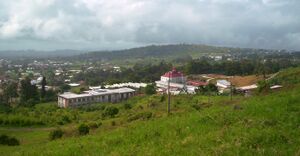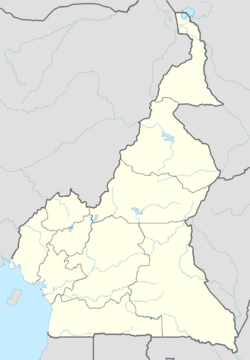Buea
Topic: Place
 From HandWiki - Reading time: 5 min
From HandWiki - Reading time: 5 min
Buea | |
|---|---|
Town and commune | |
 Buea from the foot of Mount Cameroon | |
| Coordinates: [ ⚑ ] : 4°10′0″N 9°14′0″E / 4.166667°N 9.233333°E | |
| Country | |
| Region | Southwest Region |
| Division | Fako |
| Elevation | 870 m (2,850 ft) |
| Population (2013)[1] | |
| • Total | about 300,000 |
| Climate | Cfb |
Buea is the capital of the Southwest Region of Cameroon. The city is located in Fako Division, on the eastern slopes of Mount Cameroon, and has a population of 300,000 (at the 2013 Census).[1] It has two Government Hotels, the Mountain Hotel and Parliamentarian Flats Hotel located around The Government Residential Area.
History
Buea, originally "bue", was founded by a hunter who came from the Bomboko area. Coming from the Bomboko side of the mountain, he named the new-found land in amazement as "a Bue", meaning literally a "son of bué". A prominent King of the tikar clashes with German troops during invasion. Resistance remain popular folklore; currently ruled by the Endeleys. Tea growing is an important local industry, especially in Tole. Buea was the colonial capital of Germany Kamerun from 1901 to 1919, the capital of the Southern Cameroons from 1949 until 1961 and the capital of West Cameroon until 1972, when Ahmadou Ahidjo abolished the Federation of Cameroon. The German colonial administration in Buea was temporarily suspended during the eruption of Mount Cameroon from 28 April until June 1909. Originally, Buea's population consisted mainly of the Bakweri people. However, owing to its status as a university town and the regional capital, there are significant numbers of other ethnic groups.
Ambazonian secession
In September 2017, the Federal Republic of Ambazonia declared its independence from Cameroon, with Buea as its claimed capital.[2] In late-June 2018, the Ambazonia Defence Forces began approaching Buea, and on 29 June they invaded the Mile 16 neighborhood.[3] On 1 July, separatists invaded the Muea neighborhood and battled Cameroonian troops.[4]
Notable institutions
Buea hosts the University of Buea, Cameroon's first anglophone university. It is the site of several other higher institutes of learning, including St Francis Schools of Nursing and Midwifery presently known as Biaka University Institute of Buea (BUIB) and one of Cameroon's three Catholic universities.
A handful of colonial era buildings are surviving, notably the palatial former residence of the German governor Jesko von Puttkamer. Other German colonial buildings are still standing, but some of them suffer from lack of maintenance and old age.
The Nigerian Consulate in anglophone Cameroon and the main operational hub of the Naigahelp medical aid organisation are in Buea.
Buea hosts an annex of the National Archives of Cameroon, whose main location is Yaoundé. Next door to the annex is the Cameroon Press Photo Archive, which has been permanently closed since 2001.[5]
Economy
The economy of Buea is heavily influenced by its status as a technology hub. Many young people come to the town to study at the University of Buea, and this has created a thriving environment for experimentation, innovation and risk-taking. As a result, the town has become a hotspot for startups, particularly in the technology sector.[6][7]
The University of Buea's influence has also attracted investors to the town, leading to the establishment of various tech incubators and hubs. For instance, LimbeLabs, which was founded around 2006–2008, was a precursor to ActivSpaces, one of the leading tech hubs in the country. ActivSpaces was launched in 2009 by Ebot Tabi, Bill Zimmerman, Valery Colong, Otto Akama, and Fua Tse. The hub currently has Rebecca Enonchong as Chairman.[8]
Buea's status as a technology hub has also had a positive impact on the town's tourism industry. Mount Cameroon is a popular attraction for tourists, and the town's proximity to the mountain has made it a preferred destination for visitors who want to explore the mountain and its surroundings.
In addition, the town's small size makes it easy to meet and connect with people. It also has considerably light traffic congestion, which makes it easy to move around the town quickly. The proximity of Buea to Douala, which has the largest seaport and the international airport, has also made it an attractive location for businesses.
Transport
Transportation to Buea is possible by land with the use of transport buses or private cars. Within Buea, the primary means of transportation are taxis. The closest airport is the Tiko Airport, however due to its lack of activity and proper infrastructure management, the Douala International Airport (DLA), is the closest.
Limbe was served by a 600 mm (1 ft 11 5⁄8 in) gauge plantation railway to Limbe, of the West African Planting Society Victoria.[9]
Geography
About 300,000 people live in Buea (including the villages of Bokwaongo, Muea; Bomaka; Tole; Mile 16 (Bolifamba); Mile 17; Mile 15; Mile 14 (Dibanda); Bova; Bonjongo; Likombe; Buasa; Great Soppo; Molyko; Small Soppo; Bwitingi; Mile 18 (Wonyamavio); Lower farms; Bokwai; Bonduma; Sandpit, Wonyamongo, Bulu; Bokova and surrounding villages).
Climate
Buea has a subtropical highland climate (Cfb) closely bordering on a tropical rainforest climate (Af). Because of its location at the foot of Mount Cameroon, the climate in Buea tends to be humid, with the neighbourhoods at higher elevations enjoying cooler temperatures while the lower neighbourhoods experience a hotter climate. Extended periods of rainfall, characterized by incessant drizzle, which can last for weeks, are common during the rainy season as are damp fogs, rolling off the mountain into the town below.
Buea is made-up of a tropical monsoon climate with an average temperature of 80° high and 63° low, with the hottest month being February and the coldest August. It has an average monthly rainfall of 14.7 inches.[10]
Script error: No such module "weather box".
Gallery
Notable people
- Victor Anomah Ngu (born 1926, died 2011), Professor of Surgery, Minister of Public Health
- Martin Zachary Njeuma (born 1940, died 2010), historian
- Kurt Raaflaub (born 1941), historian
- Dorothy L. Njeuma (born 1943), professor of Genetics and Embryology, politician
- Sarah Etonge (born 1967), fell runner
- Julius Akosah (born 1982), professional footballer
- Daphne (born 1989), singer
- Onyama Laura (born 1992), actress
- Clinton N'Jie (born 1993), professional footballer
- Nsang Dilong (born 1994), actress, model and social worker
- Robert Ndip Tambe (born 1994), professional footballer
- Nelvie Tiafack (born 1999), professional boxer
See also
- Roman Catholic Diocese of Buéa
References
- ↑ 1.0 1.1 Helders, Stefan. "Buéa". World Gazetteer. http://www.world-gazetteer.com/wg.php?x=1206522592&men=gpro&lng=en&des=wg&geo=-53&srt=npan&col=abcdefghinoq&msz=1500&pt=c&va=&geo=338994923.
- ↑ ADC Lands Ground Troops in Southern Cameroons, Declares War on LRC[yes|permanent dead link|dead link}}], Cameroon Journal, 10 September 2017. Accessed 19 April 2018.
- ↑ Panic grips Buea as soldiers battle separatists, Journal du Cameroun, 29 June 2018. Accessed 29 June 2018.
- ↑ Muea in lockdown as soldiers battle separatists, Journal du Cameroun, 1 July 2018. Accessed 2 July 2018.
- ↑ Nsah, Solomon Kekeisen (June 2017). "The Cameroon Press Photo Archive (CPPA) Buea in Crisis 1955-2016". Vestiges: Traces of Record 3 (1): 65–81. ISSN 2058-1963. http://www.vestiges-journal.info/index.php/Vestiges/article/view/15. Retrieved 31 August 2017.
- ↑ "Cameroon's high-tech hub" (in en-GB). BBC News. https://www.bbc.com/news/av/business-36054263.
- ↑ CAMEROON, ORANGE. "Silicon Mountain Conference 2022 – Orange Cameroun reinforces its promise to the tech innovation industry" (in en-gb). https://www.businessincameroon.com/telecom/0211-12828-silicon-mountain-conference-2022-orange-cameroun-reinforces-its-promise-to-the-tech-innovation-industry.
- ↑ Odunowo, Olanrewaju (2018-08-10). "Cameroon’s Silicon Mountain: Its History, Resilience and Future" (in en-US). https://techcabal.com/2018/08/10/cameroons-silicon-mountain-its-history-resilience-and-future/.
- ↑ http://www.gouverneur-ebermaier.de/english/narrow_gauge_railways.htm[yes|permanent dead link|dead link}}]
- ↑ "Buea Climate, Weather By Month, Average Temperature (Cameroon) - Weather Spark" (in en). https://weatherspark.com/y/61816/Average-Weather-in-Buea-Cameroon-Year-Round.
- ↑ "Climate Buea". Climate Data. 2022. https://en.climate-data.org/africa/cameroon/southwest/buea-3985/.
External links
- Mount Cameroon Inter-communal Ecotourism Board - formerly known as Mount Cameroon Ecotourism Organisation, abbreviated as Mount CEO
 |
 KSF
KSF










